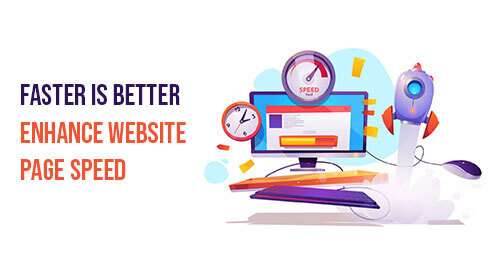
Faster is Better: Enhance Website Page Speed
Website page speed is essential to any business's ability to gain traffic. It's so crucial that Google has included it as a ranking criterion. Google has provided a suite of tools for developers and webmasters to increase the speed at which webpages load. Google Lighthouse is one of these tools.
But how does Google's website page speed insight tool operate? Furthermore, how does page speed impact SEO? Everything you need to know is contained in this article.
In the past, the PageSpeed Insights Tool wasn't very accurate. Most of the information there was easily accessible elsewhere and didn't show speed. But Google just improved the tool, making it far more useful. Unfortunately, understanding it is far more difficult.
However, PageSpeed Insights, which is really powered by Lighthouse but presents the information in an understandable fashion on a web page, has helped this technology gain popularity among SEOs.
popularity among SEOs.
What Exactly is Page Speed?
Page speed is an important metric measuring the time a webpage takes to load. Factors like images and scripts can affect page speed, which can vary based on several variables, such as server speed, webpage type, connection type, and user device. While Google PageSpeed Insights was previously inaccurate in determining page load time, it's important to note that loading time can have various implications. For instance, certain scripts can be delayed until after other essential components have loaded to ensure a better user experience. However, it's important not to delay loading essential scripts critical to a website's usability or functionality, as this could negatively impact the user experience.
Because of this, Google PageSpeed Insights was previously not very accurate. You weren't given information regarding how quickly your website loads. Of course, the loading time has a variety of interesting points. For example, you may want to run some scripts towards the end because they don’t need to be used initially.
The overall loading time might be longer because it might take a long time to complete loading. It is a manageable issue if the site can still be used until then.
Let's imagine, for illustration, that you wish to execute an exit intent pop-up script. It takes 5 to 10 seconds for the script to load. The user should only see it after waiting approximately 20 to 30 seconds. Launching your script right away can delay loading other crucial components, such as the material that should be displayed above the fold as soon as the user visits the page. This would be detrimental, especially because you won't use the script for 20 to 30 seconds. So you can postpone loading the script until everything else that is vital loads in to give the user a better experience.
You may not want to load a script that is essential to the website's usability or one that makes the menu function near the end, though. Because the user wouldn't be able to use that function before everything else loaded, this would harm the user experience.
What is Site Speed Metrics?
Site speed metrics are performance indicators for websites that track things like render time, time to first byte, and page load time. These metrics assist website owners in identifying areas that may benefit from optimization to enhance the user experience and search engine rankings.
Why are Website Performance Metrics Important?
Information provided by website performance metrics can be valuable in understanding a website's effectiveness and identifying areas for enhancement. Through monitoring metrics such as page load time, bounce rate, and conversion rate, website optimization can be achieved to create an improved user experience and generate increased revenue.
When a website has a high bounce rate, it may indicate that it is not meeting customer expectations. In contrast, a low conversion rate may suggest that content or design improvements are necessary to boost user engagement.
4 Steps to Identify Which Website Page Speed Metrics to Track
Here are some of the steps to identify website page speed metrics. Let’s have a quick look at them:
Set clear goals for your website
The first step in deciding which page performance indicators to monitor is establishing defined objectives for your website. These objectives may be focused on user experience, such as decreasing bounce rates or increasing time spent on the site, or they may be based on business goals, such as boosting revenue or conversions.
For instance, metrics like time to first byte and server response time may be more important for your website's ability to sell products than others like Document Object Model (DOM) content loaded or fully loaded time.
Once your objectives are clear, you may decide which page performance metrics are most important to monitor and improve. To ensure that these metrics align with your website goals, examining and modifying them regularly is critical.
Consider your target audience and their browsing behavior
Page speed expectations vary depending on the user type. Thus, it's critical to prioritize metrics that suit the requirements and preferences of your target audience.
Younger audiences, for instance, are less patient with slow loading times and prefer more aesthetically appealing content. In contrast, older audiences can place more importance on reading and ease of navigation. You may tailor your website to your target audience's demands and enhance their overall experience by studying their browsing habits.
It's critical to adjust your strategy in light of the requirements and habits of your target audience. You may find out which indicators are most crucial for enhancing the user experience and accomplishing your business objectives by analyzing data on user behavior.
Consider the device your target market uses to conduct online searches
Devices vary in their capabilities and restrictions. You may improve the user experience of your website by monitoring the page performance metrics that are most pertinent to the devices used by your target market.
For instance, metrics like time to first byte and overall page load time may be more significant than those related to desktop users with better Internet speeds if your target audience is mobile users who are frequently on the go.
However, tracking metrics like "first contentful paint," a web performance metric that gauges how long it takes for a user to see the first piece of content after visiting a website, may be more pertinent if your target market is made up of professionals who use desktop computers.
Identify your target market’s location
The location of your target market is one of the most important considerations when deciding which website page speed indicators to monitor. The Internet infrastructure in your target market's location can then be examined to ascertain which metrics are most pertinent for gauging page speed.
Consider tracking metrics particular to that region if your target audience is predominantly located there, such as network connections or device types frequently used there.
Conclusion
In conclusion, website page speed metrics are critical for SEO because they directly impact the user experience and rankings. A slow-loading website can lead to a high bounce rate and low user engagement, ultimately hurting your website's search engine visibility.
Search engines like Google have made page speed a significant factor in their ranking algorithm because they understand the importance of delivering fast and efficient search results to their users. Therefore, optimizing your website's page speed metrics is essential by reducing server response time, minimizing image and file sizes, leveraging browser caching, and using content delivery networks.
To optimize your website's performance metrics, contact the best site speed optimization agency offering website audits, performance, and optimization. Our team of professionals can analyze several variables, including page size, server response time, and image optimization, to produce comprehensive statistics on the speed of your website.
With our cutting-edge technology, you can be confident that we will offer precise and useful insights to enhance your website's speed and general efficiency, which will eventually result in a better user experience for your visitors.





